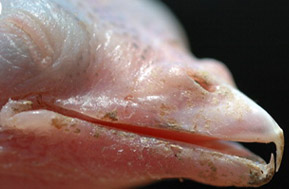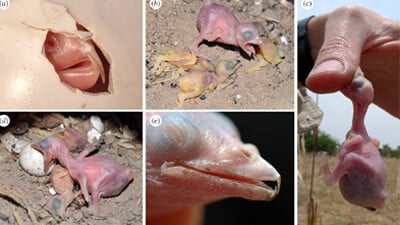How does Gozel Haobil take care of himself for ideal living conditions? He kills his neighbors. Why does this happen and where has the hook gone with which the murder is carried out? The answers, including a video of Haovil in action, in the article before you

Yonat Ashhar and Noam Levithan Galileo
In a burrow in the ground a small chick hatches from its egg into complete darkness. He does not know it, but he is not the first chick to inhabit the underground nest: a larger chick, which hatched some time before him, is waiting for him in the darkness. The big chick is a killer equipped with two formidable hooks that protrude from its beak. A few minutes later he went into action.
Under the cover of darkness, he pounces on the little chick, and with movements that seem uncharacteristic of a bald chick that looks so helpless, he grabs his victim, opens and closes his beak, terrorizing the little body and shaking it.
This horror scenario was photographed, in black and white with an infrared camera, by Claire Spottiswoode from the University of Cambridge in England and Joron Koorevar from ECO Logisch in the Netherlands. In the video we see a baby shrew (Merops pusillus) being attacked by its step-brother - a baby shrew (Indicator indicator).
social parasites
The honeybee is a small African bird, known for connecting with humans and leading them to beehives (hence its English name: Honeyguide). When the people drive the bees away with smoke and open the hive, the birds eat the bee eggs, larvae and wax.
There are persistent rumors that the beekeepers lead other animals to beehives - especially the honey badger, which is resistant to bites and is able to open the beehive for the birds. But unfortunately, there is no reliable evidence that such cooperation actually takes place and the only nature film in which this behavior is "documented" was directed with the help of a tamed and stuffed badger of Obil.
Aviles have another unique feature: they are social parasites, meaning the females lay their eggs in the nests of other birds. Social parasitism is not uncommon among birds. In some species, the parasitic chicks grow up with the "legal" chicks - for example, the cuckoos that live in Israel lay their eggs in crows' nests and the chicks grow up together relatively peacefully. In contrast, nestlings of other cuckoo species tend to throw the host's eggs or nestlings from the nest to their deaths.

assaulting a person
For years, scientists suspected that the obilis were also engaged in killing their step-siblings. Since the nests of the crickets are underground (in Africa they are mainly found in the burrows of shrews), the owls cannot throw the eggs from the nest: it was assumed that they take a more direct approach. The sharp hooks on the beaks of the chicks hinted at this possibility, and to this must be added the fact that no more chicks were ever found in the nests where there were ovile chicks.
The only case where such an attack was observed was in 1952: Gordon Ranger held two chicks in his hand, a parasite chick and a host chick, and the parasite chick attacked the smaller chick and killed it. It's unclear what Gordon tried to do next with the murderous chick, but it somehow managed to pierce Gordon's tongue.
To watch the video showing the lead chick murdering its nestmate
The disappearance of the murder weapon
In the article published by Spotizud and Korfar in the journal Biology Letters, they presented for the first time a video showing the aggressive behavior of the Obil chicks under natural circumstances. The chicks attacked their step-siblings in all ten nests that were photographed. The attacks lasted less than three minutes, and in all cases the surrogate chicks died. About two weeks later, having completed what was apparently their only task, the hooks were absorbed into the developing chick's beak and gradually disappeared.
The researchers discovered that the owls have another method for getting rid of the surrogate chicks, even before they are born: when the owl female lays her egg in the nest, she punctures the other eggs in the nest in her beak and thus prevents their development. The chick eliminates the shrew chicks that manage to survive this attack
.
The reason for this behavior, as cruel as it may seem to us, is clear: the lead chick receives more food and care from its adoptive parents when it has no competitors. In most birds, chicks that grow up together in a nest share much of their DNA with each other, so natural selection does not create a preference for fratricide.
In the case of a social parasite, there are no such restrictions, and this is how the strategy we see in the leaders developed: the behavior of the mother, the behavior of the chick, and also its physical characteristics - especially the hooks on its beak and its strong bite - are all aimed at creating an ideal breeding environment for the chick. There is no doubt that the parasitism of the ovules is a serious problem for crickets in the southern part of Zambia, where the study was conducted.
Out of 172 shrew nests examined, about two-thirds were visited by the parasitic bird. It seems that the shrews are trying to combat this: more than half of the nests that contained the eggs of the honeyguides have been abandoned. If the crickets are destined to lose their chicks, it is better for them to give up the nest before they invest many resources in it, and when they still have a chance to start a new nest. In other places where social parasitism is common the hosts sometimes recognize the foreign egg and throw it out of the nest. Considering the high cost of this parasitism for the shrews, it is possible that such a strategy will develop in the future for them as well.
for further reading:
The original article:
Spottiswoode, C. & Koorevaar, J. A stab in the dark: chick killing by brood parasitic honeyguides. Biol. Letters (2011). http://bit.ly/nzaYPT
The full article was published in Galileo magazine, December 2011

12 תגובות
The ultra-orthodox are also no less bad parasites
A parasitic sect that multiplies and is fed by the money of the seculars and is protected by their soldiers who are a shield for it in the face of the enemy's bullets while they are doing pro varbo, and bring at least 10 children.
Lasaf, the official name of the "honey guide" in Hebrew is Obil and is named after the act of transport, since the bird leads people to the honey. The "little shrew" - unlike the dwarf shrew - does not have an official Hebrew name and indeed its name can be translated in English as a small shrew (or more precisely a small bee eater). According to the translation of the Latin name, the more correct name is "small shrew", and it is acceptable to base the Latin name on the translation of animal names that do not yet have an official Hebrew name.
By the way, contrary to what you wrote, there are no reliable observations at all of the transport of honey badgers by the Avile. Ed Jung's blog has a great summary of the topic and you can also find a link to a wonderful nature film in which you see a stuffed animal from Obile leading a tamed honey badger:
http://www.youtube.com/watch?v=D544WoTj5qI
Very interesting ..
Thanks
collect -
I would appreciate it if you could direct us to the reliable testimonies about honey guides who guide badgers to hives.
I saw the response you sent to Galileo but the articles you referred to do not report such evidence.
In a study conducted 20 years ago, the researchers looked for - and did not find - any reliable evidence
http://onlinelibrary.wiley.com/doi/10.1111/j.1523-1739.1990.tb00272.x/abstract
If there are reliable testimonies collected since then - we have not been able to find them. Ed Jung summarizes the issue here:
http://blogs.discovermagazine.com/notrocketscience/2011/09/19/lies-damned-lies-and-honey-badgers/
Of course, it is possible that the collaboration does exist and no one has simply seen it until today, but if this is the case, the phenomenon is apparently not very common.
To say that "it doesn't make sense" that the Obils cooperate only with people is not really a strong argument. The evolution of man took place in Africa - he did not get there yesterday. There are many cases of interactions between two specific species of animals - why not between a bird and humans? (By the way, have the obilis or honey badgers, as a species, actually existed longer than man? They may have, but I would not declare this as fact without information on the phylogeny of these species).
To assemble
Thanks for the enrichment.
And thank you I came out clean, without irritation 🙂
The vernacular name of the studied shrek is small shrek (also in other languages)
Not "tiny", the popular name of the "obile" is directly translated from its scientific name
And as in other languages it is called the "honey guide",
Contrary to what is written in the article, there are many reliable observations about the "guide" who leads
Honey badgers, there are "guides" also in Asia and there they also lead bears.
Badgers, bears and guides exist "slightly" longer than people and therefore assume that
The guide developed the talent of transport only for people ….. excessive.
to Husham
Like the cuckoo, the owl also lays its eggs in burrows (nests) of different species
The research done on shrekrakim could have shown similar activity in burrows as well
and in the nests of other bird species,
Many parasites have developed complete dependence on hosts, but cases are also known in which the parasites "learn" to go through all life cycles without hosts,
Referring to the cuckoo there is a mistake as there are cuckoo chicks who throw their "brothers" out of the nest
while others grow fast and withhold food from their "brothers" and thus "murder" them.
to Yair
"The eagle kills its biological brother" ……. The Bible.
To think open
According to your response, it is difficult to attribute to you an "open mind" and yet
As the "tree hugger" on duty, I refer you to Rem.
The article seems partial to me (only one side is told).
When this type of behavior is observed, I think it should be checked
The thesis about the private ecological equivalence of this system.
That is, since the clowns didn't disappear completely.
Where is the balance of this system?
Can the lead survive on their own without rustling?
It's a shame even when there is an article in which there is no reason for a verbal struggle
People come and go with mindless opinions to express .... nonsense.
The eagle also murders his biological brother (with whom he actually shares a close DNA).
So does the honey bee queen,
"The first queen that hatches from the hatch, stings the queens that have not yet hatched, while they are in the hatch."
http://he.wikipedia.org/wiki/%D7%93%D7%91%D7%95%D7%A8%D7%AA_%D7%94%D7%93%D7%91%D7%A9
Well, then where is the tree hugger who will come and say that this bird must be behaving like this if it cooperates with humans. Humans have managed to pollute it too with their dark energy... (here usually appears some brainstorming about the structure of the universe and balance and dolphins and all kinds of nonsense)